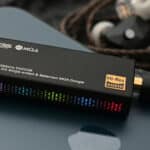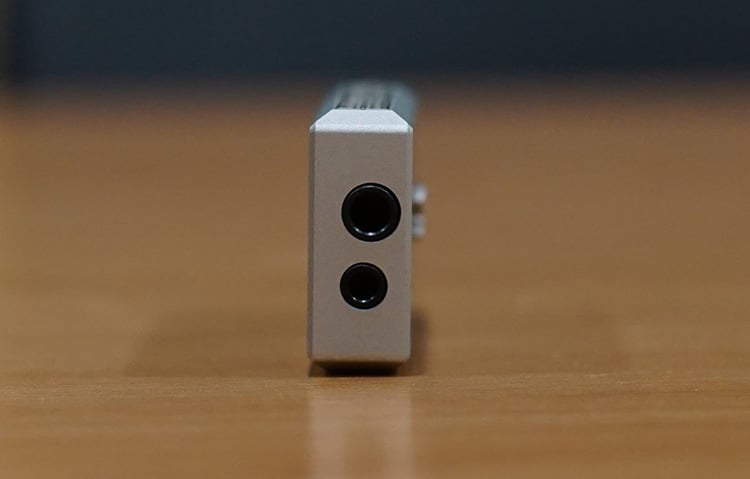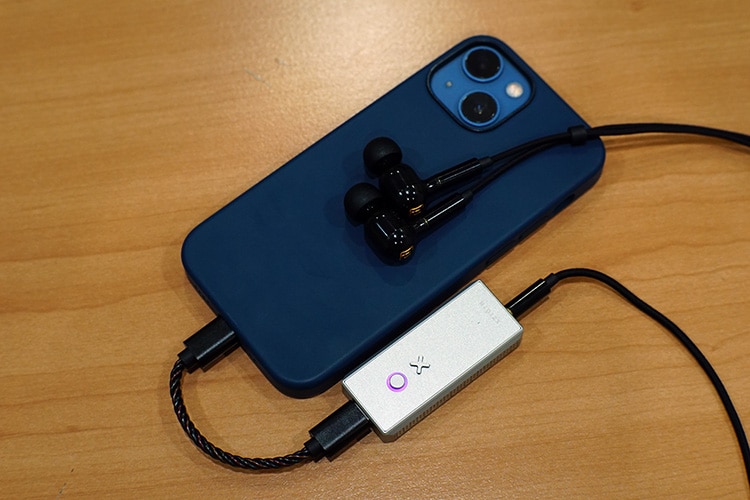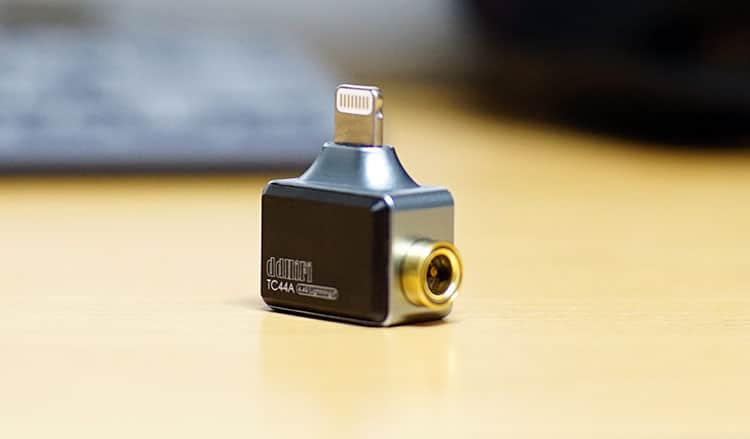This is a review of the Hidizs XO which is an MQA-Certified portable DAC/Amp dongle with a dual DAC and balanced output design. It is priced at $99.
Disclaimer: This sample was sent to us in exchange for our honest opinion. Headfonics is an independent website with no affiliate links or status. We thank Hidizs for this opportunity.
To read more about Hidizs products we have previously covered on Headfonics click here.
Note, that this article follows our current scoring guidelines which you can read up on here.
Hidizs has been releasing wonderful budget products over the years. DAP, amps, and earphones, including Bluetooth-capable devices. They usually offer refreshes of their DAPs and DACs such as the recent AP80 Pro-X, and the S9 Pro, offering internal upgrades but only slight changes on the externals.
Hidizs has me surprised with its newest dongle-DAC offering called the Hidizs XO. It is a completely different-looking dongle-DAC, even with RGB LEDs! The DAC implementation is also impressive with the Dual ES9219C DAC chip.
The Hidizs XO is priced at $99, this is Hidizs’s cheapest dongle yet. Hidizs may have another crowd favorite up on its sleeves.
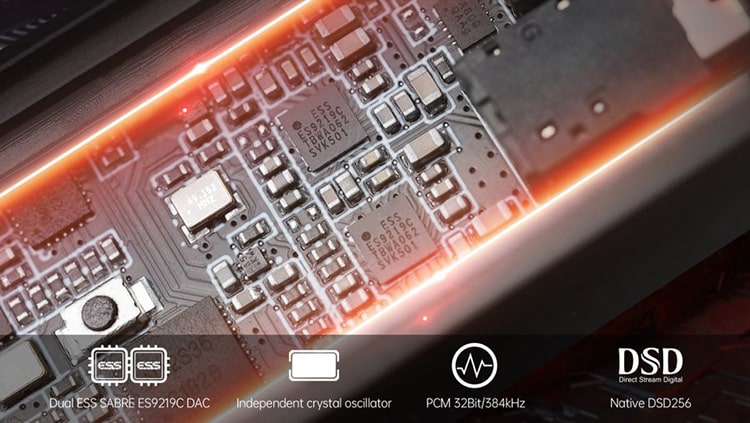
Tech Highlights
Inside this slim profile is a dual ESS Sabre E9219C DAC, (famously seen in FiiO BTR5 2021), & independent crystal oscillators. With the current configuration, the high-precision independent crystal oscillator allows synergy and the most accurate clocking for both DACs.
It has an impressive low SNR of 118dB / 119dB and THD+N (total harmonic distortion + noise) of 0.0015% and 0.0005% for PO 3.5mm and Balanced 2.5mm respectively.
The DAC is capable of up to 32bit/384kHz PCM, DSD256, and MQA 16X. This means it can fully decode and play music in a lossless format, particularly when using Apple Music and Tidal on your mobile device or laptop.
It has a dual output with both 3.5mm SE and 2.5mm balanced. This dongle packs in a lot of power, not only does it power IEMs but it can also handle high-impedance headphones.
Design
The RGB LED lights on the side are truly eye-catching, bringing out the gamer inside of me. I felt it will totally look great with my gaming rig. If that’s not something you’re into, the great thing about is that it can be turned off or turned on. So, it totally depends on your style. When I’m in a more festive and quirky mood, I bring myself to turn the RGB LED on.
The feel of the case is exquisite. The XO has a solid build with an aluminum alloy shell. Upon closer look, the windows of the RGB LEDs are multiple etched “H” which is carried out with meticulous metal processing.
I really like that the XO has detachable cables on the output side. This makes it easier to replace once the cables break. But more importantly, I can use a direct lightning cable, removing the need for an adapter. I hate using adapters as it usually disconnects from time to time.
I/O and Controls
The input port is a USB-C female port while the output port is a 3.5mm SE and a 2.5mm balanced. A USB-C to USB-C and a USB-A adapter are included in the package. Hidizs was generous enough to send in a Hidizs USB-C to Lightning cable to be iOS compatible.
The Hidizs XO has two buttons – the X and O buttons. The X button toggles the different light modes with 15+ lighting effects! The O-button is for the filter mode switch. There are no specific names for the filters but the O ring does flash a red and blue color when toggled.
The two filters are very similar in sound. The blue filter is a linear phase fast roll-off while the red filter is a hybrid roll-off filter. The main difference is found in the 20-60kHz range. The difference between the two is very little. In fact, when testing them blind, I can hardly differentiate the two.
Packaging & Accessories
Compared to the other Hidizs packages before, I find the Hidizs XO packaging to be more simple, compact, and reusable. Instead of a carton box, it’s placed in a small hard plastic box that can double as a dongle + IEM case that one can carry around.
The box is just right to enclose the XO, along with the cables and accessories inside. Do note that the accessories cardboard box is glued below where the DAC sits. Inside is the Hidizs XO dongle, a USB-Type-to USB-A Adapter, a USB-Type C to USB Type C cable, a warranty card, and a user manual.
Sound Impressions
Summary
The Hidizs XO is a natural-sounding DAC with a clean and lush timbre. For a compact form factor, it exceeds expectations as it extends well in both lows and highs while having good soundstage and imaging. Different IEMs alike can shine with their own sound signature as the XO has little to no coloration.
The lower end gives a good and tight impact, making it sound dynamic rather than stale. Also, with a clear and articulate midrange. Instruments and vocals are presented well, making it easy for details to unfold.
Timbre
There is very little to no coloration with the XO. It does at times lean on the warm side, but generally, it is very neutral. XO also does well in handling sensitive IEMs. It is clean and quiet, with no unwanted hiss. It also has a very lush timbre, which is more highlighted in the midrange region.
Instruments are projected well. They are lush and articulate, wherein textures from wind instruments are pronounced and can be very well distinguished. String instruments are also crisp and full-bodied.
Vocals, both male and female, also sound very natural and rich. Voices sound well represented in their entirety, embodying vocal techniques and textures.
Upper frequencies are also well extended with the amount of heft. Cymbals and acoustic guitars do have the right amount of presence, adding an extra layer of detail, and making the overall sound frequency full and well-represented.
Staging & Dynamics
The soundstage is wide and very impressive for a below $100 DAC. The imaging is very well executed, and busy tracks have enough gaps that don’t clump together, allowing different layers to breathe and be placed in a unidirectional plane. It’s a very fun dongle-DAC, not sounding dull and flat at all.
Synergy
Power
The output power of the Hidizs XO is 78mW+78mW and 195mW+195mW @ 32 ohms on 3.5mm SE and 2.5mm balanced respectively, which is quite impressive for a DAC this size.
It was quite surprising that the Hidizs XO was able to power up the AEON 2 Closed at comfortable levels. Although, it is still underpowered for my taste. But still, quite surprised to bring it up to listening levels. It is good enough to use when in a pinch.
When using with IEMs, there were no hiss or static sounds when using sensitive IEMs such as the Campfire Audio Solaris. The floor volume output is low enough to have a comfortable output with few notches on the volume levels.
Pairings
The XO is easy to pair since there is not much colorization. It does give a rich overall timbre, enhancing the IEM’s natural profile.
I find the Periodic Audio Beryllium V3 to be a good match as it further enriches the IEM’s sound profile. Bass are punchier and the midrange timbre is further enhanced. This pairing makes a very good low-footprint travel companion.
Select Comparisons
Moondrop Dawn
$69.99
Technical
The Moondrop Dawn and the XO have different DAC chips inside. The Dawn has the Cirrus CS43131 chip while the XO has a dual ESS Sabre ES9219C. Although both DACs support decoding capabilities of up to 32-bit/384kHz PCM and DSD256, only the XO has MQA support (up to 16x).
Both also have different outputs. The Dawn has only 1 – a balanced 4.4mm output while the XO has 2 – a 3.5mm SE and a 2.5mm Balanced.
The XO can give more power with the balanced side, with 195mW+195m compared to Dawn’s 230mW, which are both evaluated @ 32 ohms.
Design
Self-explanatory but keep it tight. For headphones and IEMs include the cable. Do not include packaging and accessories in these sections and do not make these sections long.
Performance
Overall, the two are very similar in terms of sound signature. Both have tight lows and well-extended highs. Both have natural presentations, with very minimal colorations. I must say they are a punch above their price range and are very competitive in pricing.
Both have a good amount of punch when it comes to the lower frequencies. It is not too strong to leave a boomy feel but enough to inflate and make the bass feel. Both sound very dynamic, but at times lacking in body.
Both have a clean and natural midrange presentation. Vocals are displayed with enough articulation to discern texture and technique. However, the XO has a lusher timbre, which reveals much more details when listening intently.
With the XO, vocals feel brighter and richer and very well executed. The Dawn by no means fell behind, but at times it’s a step lower than XO’s midrange quality.
Imaging and soundstage are both okay for their price range. However, the XO does better in both aspects. Imaging is pleasantly constructed, along with a wider soundstage. The depth and height are similar for both.
ddHiFi TC44A
$59.99
Technical
The TC44A has the Cirrus CS43131 DAC chip inside while the Hidizs XO has a dual ESS Sabre ES9219C. Although the ddHiFi TC44A doesn’t have MQA support, they both have the same decoding capabilities with support for up to 32-bit/384kHz PCM and DSD256.
The output of the two is also different. The Hidizs XO has a 3.5mm SE and 2.5mm Balanced output while the TC44A has a 4.4mm SE output.
TC44A can supply 50mW of power at 32Ωs while the XO can give a lot more power with 78mW+78mW SE and 195mW+195mW balanced @ 32Ωs on 3.5mm SE and 2.5mm balanced respectively.
Design
Visually, these are very different devices. The TC44A is a T-shaped OTG plug with a DAC chip inside, eliminating the need for cables. The XO is a more conventional Dongle-DAC type with a unit + cable form.
Both look very durable with their metal casing and lightweight design. Using them in action, I find both of these are tough to break and can take a beating.
Performance
Overall, the two are very similar in terms of sound signature. Both have tight lows and well-extended highs. Both have natural presentations, with very minimal colorations. I must say they are a punch above their price range and are very competitive in pricing.
The bass is tighter and punchier on the XO than on the TC44A. The TC44A has a slightly noticeable decay upon careful observations. Instruments such as bass and drums have a more energetic attack and slam, wherein more impact is felt in drum and bass-heavy tracks.
The timbre on voice and instruments are lusher on the XO. There is a clear difference between the quality and texture which is a notch higher than the TC44A. There is no mistake that the Hidizs dongle is superior in terms of its articulation and presentation.
Although the TC44A does have good imaging and soundstage, the XO just does it better with a more dynamic range. TC44A at times sounds flatter, and lacking in depth. The XO also has more clarity, which is more noticeable due to its wider soundstage advantage.

ddHiFi TC35C
$59.99
Technical
The ddHiFi TC35C has a Realtek ALC55686 DAC chip while the XO has dual ESS Sabre ES9219C. The different DAC chip allows for different capabilities. Although both support up to 32-bit 384kHz PCM decoding, only the XO has to support up to DSD256 and MQA (16x).
Both DACs have a 3.5mm SE output, with the XO having a 2.5mm balanced option. They also differ in power capabilities with TC35C supplying only 30mW at 32 ohms while the XO can supply 78mW+78mW and 195mW+195mW at 32 ohms on 3.5mm SE and 2.5mm balanced respectively.
Design
Similar to the ddHiFi DACs, the ddHiFi35C is a T-shaped OTG plug with a DAC chip inside. There are no cables between the input and outputs, which makes it compact in size. The XO is a unit + cable design, but with removable cables and a very low profile for the unit.
Both are made of aluminum, which makes them lightweight and durable. Both are very easy to use. When carrying it on the go, there are no problems with disconnections and the like. Performance
Performance
Overall, the Hidizs XO has more dynamic range and aggressive attacks than the TC35C. The TC35C sounds flat and boring at times, whereas the Hidizs XO outperforms the former with punchier attacks across the frequency range.
Both lower and upper frequencies are more pronounced with the XO. Both have an aggressive feel to them, creating more change in amplitudes. With the TC35C, both ends of the spectrum seem to be more laid back and flat. There is not much change and it easily blends into the background.
The Hidizs XO has a nice thick accurate timbre that accurately projects both vocals and instruments. The TC35C pales in comparison where the vocals are a bit hollow and the instruments are thinner and felt lacking in texture.
Although both replicated midrange regions quite well, the Hidizs XO has a more natural and thicker timbre, which expresses a more realistic replication.
The XO is also better with its imaging accuracy. It has more gaps between layers which impressively forms a cohesive audio presentation. The TC35C at times clumps layers which makes the sound feel flat and dull.
Both give a frequency range. Sensitive IEMs were handled well without hiss or noise when no music is played.
Our Verdict
For a sub $100 budget dongle-DAC, the Hidizs XO by far exceeded my expectations.
Along with its impressive performance on the technical side, I did like that it has 1.) a removable cable on the output side, giving iPhone users the option of using a USB-C to Lightning cable 2.) flexibility of SE and 2.5 balanced options 3.) compact and light device easy to use for travel.
The device is a good starting point for people wandering in the hobby or people who are more into a minimalist smartphone set-up. It does elevate the sound quality wherein it is noticeable to justify the purchase.
Hidizs XO Technical Specifications
- NET WEIGHT: 11g.
- DIMENSIONS: 55 x 24.5 x 9.35mm
- DAC/AMP CHIP: ESS ES9219C
- OUTPUT(S): 3.5mm TRS + 2.5mm TRRS
- FREQUENCY RANGE: 20Hz – 40kHz
- THD+N: 0.0015% (3.5mm), 0.0005 (2.5mm)
- SNR: 118dB (PO), 119dB (BAL)
- CROSSTALK: 76dB (PO), 118dB (BAL)
- OUTPUT POWER: 78mW 32Ohms(3.5mm)/ 195mW 32Ohms (2.5mm BAL)


